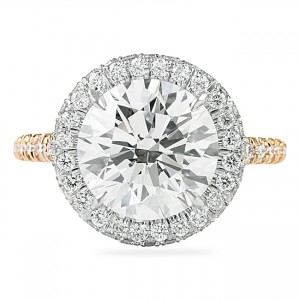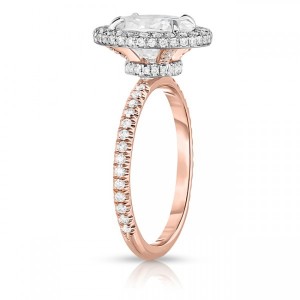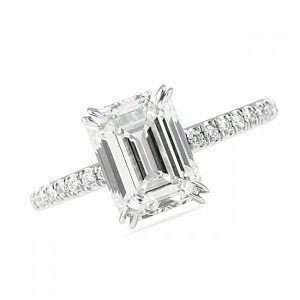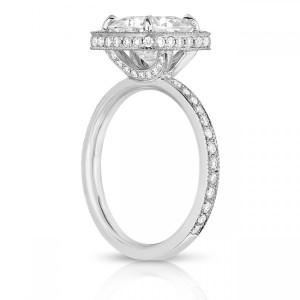In our last blog topic we went over some good words to add to your dictionary of diamond terms when it comes to engagement rings. In this post we will go over some basic definitions of words when it comes to the anatomy of a ring. Remember the design is what is going to make or break the look of your engagement ring; you can have an unbelievably top quality center diamond but if it is placed in the wrong setting it will be ruined.
Setting- the entire ring, save for the center stone. The setting can also be referred to as the mounting. The mounting or setting hold the center diamond in place and secure it to your hand. Without the setting, it would just be a loose center stone with nothing anchoring it in place. In almost all circumstances, the term setting includes not only the metal it is made up of, but also any stones on the ring (Except the center!) would be grouped into that category as well
 Halo- a frame of diamonds that perfectly encases the top view face of the diamond. A halo increases surface area of the diamond when viewed from the top or aerial view and is a very popular style for many of our custom engagement rings.
Halo- a frame of diamonds that perfectly encases the top view face of the diamond. A halo increases surface area of the diamond when viewed from the top or aerial view and is a very popular style for many of our custom engagement rings.
Seamless Halo- a quality we are well known for. This is when the halo is custom made specifically for one diamond resulting in a perfectly seamless and gap-less fit.
Halo Gap- when there is a distinct gap/ separation between the halo and the center diamond. This usually means that the setting was not custom made to the halo. Since it is not sitting properly within the setting.
 Double Edge Halo- when you add an extra edge of diamonds along the outer perimeter of a halo. This means your halo has 2 complete edges filled with diamonds on it. The double edge halo gives a sparkly look specifically from the side view of the ring. Any angle you look at the halo there will be diamonds! This does not increase surface area of the diamond from the top, it only creates a more finished appearance and shows less metal on the halo.
Double Edge Halo- when you add an extra edge of diamonds along the outer perimeter of a halo. This means your halo has 2 complete edges filled with diamonds on it. The double edge halo gives a sparkly look specifically from the side view of the ring. Any angle you look at the halo there will be diamonds! This does not increase surface area of the diamond from the top, it only creates a more finished appearance and shows less metal on the halo.
Double Halo- adding a second halo to the top flat surface of the halo. This means double the amount of surface area on the ring. The double halo ring gives the biggest face up appearance from all the setting options that you have for a bright and glitzy look
Prongs- the tips that hold a diamond in a place. A traditional setting will have 4 or 6 prongs depending on the cut or shape of the diamond.
Claw Prongs- when the metal tips securing the diamond in place are mad as thin as possible as to not take away from the beauty and overall look of the center-stone
 Split-Claw Prongs: refers to prongs that have tiny splits in them at the top. This can give an engagement ring a more classic appearance and a vintage feel. We see this most often with cut cornered fancy shape diamonds such as radiant, emerald or asscher cuts. The split can start right at the top near the girdle of the center-stone or it can be split throughout
Split-Claw Prongs: refers to prongs that have tiny splits in them at the top. This can give an engagement ring a more classic appearance and a vintage feel. We see this most often with cut cornered fancy shape diamonds such as radiant, emerald or asscher cuts. The split can start right at the top near the girdle of the center-stone or it can be split throughout
Basket- when a ring does not have a halo, it can be held in place by prongs. If the diamond is a fancy shape center such as an oval, cushion, pear, radiant, etc it can use an extra support system such as a basket. The basket is connected to the prongs of the ring. Our most well known settings feature a basket that includes diamonds for a supportive but still sparkly look.
Gallery: The area between the center-stone and above the shank of the ring; this can include the basket and stems that connect to the prongs. This is a great place to add some beautiful finishing touches to your ring.
Pave Wrap or Scarf: As seen on our most popular ring styles such as model# RS-63, RS-119, RS-122, RS-217 and more. This can also be consider an “under-halo” as pave diamonds wrap fully around going over the prongs and is another great way to detail your special engagement ring
 Prong to Prong Wrap: When the diamonds go along the basket area but stop at each prong. A nice alternative to the full wrap, this style can also include diamonds going up the stems and along the prongs to give you a completely diamond encrusted gallery. See model# RS-275 shown to the right as a perfect example of this.
Prong to Prong Wrap: When the diamonds go along the basket area but stop at each prong. A nice alternative to the full wrap, this style can also include diamonds going up the stems and along the prongs to give you a completely diamond encrusted gallery. See model# RS-275 shown to the right as a perfect example of this.
Shank- the actual band of the ring. The shank is the portion that is actually holding the ring on your finger. This can have diamonds or just be solid metal
Stems- The portion of the ring that connects the halo or basket holding the diamond to the shank of the ring. On many Lauren B rings we add pave diamond detailing to the stems to give your custom engagement ring some more profile appeal.
 Cathedral- When the band of the ring reaches up toward the halo or basket holding the diamond. A cathedral ring gives a more domed appearance and can feel more secure on the hand. We like the flowing appeal of these special rings. Here is a beautiful cathedral style engagement ring from Lauren B with an emerald cut halo
Cathedral- When the band of the ring reaches up toward the halo or basket holding the diamond. A cathedral ring gives a more domed appearance and can feel more secure on the hand. We like the flowing appeal of these special rings. Here is a beautiful cathedral style engagement ring from Lauren B with an emerald cut halo
Pave set- small diamonds or gemstones that are set close within the metal. The gems are separated and held in place by little beads of the setting’s metal. The prongs holding the stones essentially disappear into the background of the ring giving the look of a continuous surface of diamonds
Shared prong- usually in a diamond wedding band, when the diamonds do not individually have their own prongs. Instead, each diamond shares a prong with the neighboring diamond. A perfect example of a shared prong eternity band with round diamonds weighing almost 5 carats
 Bright cut- a type of pave where there is a thin wall of metal along the edge. This is a traditional pave style giving a very classic and clean edged look.Not to be confused with a channel setting, there are tiny beads between each diamond which still makes it considered as a pave setting. This is a custom ring from Lauren B features three rows of bright cut pave set diamond on the band.
Bright cut- a type of pave where there is a thin wall of metal along the edge. This is a traditional pave style giving a very classic and clean edged look.Not to be confused with a channel setting, there are tiny beads between each diamond which still makes it considered as a pave setting. This is a custom ring from Lauren B features three rows of bright cut pave set diamond on the band.
Fish-tail- The extra metal etching of tiny “V’s” next to each pave diamond that gives each stone a more distinct appearance and makes the metal reflect more light. This requires the setter to hand etch each next to each pave stone giving the metal a more sparkly appearance as well.
Bezel- a small circle of metal that capsules a diamond, usually in a circular shape. A bezel is like a halo but without any diamonds. The bezel rings can be plain or have migraine detailing
Three Row Band or Triple Sided Band: when the band of the engagement ring has three rows of diamonds set in a domed formation. This style requires a lot of attention to detail and labor but the resulting effect is sparkle from every angle for a gorgeous look.
Two-Tone: When a ring features two different metal colors. The most popular combination would be either rose gold with white, or yellow gold with white. The contrasting colors and unique flair provided by the color metal is a strong trend of late in the engagement ring world.
Floating Appearance: Refers to when the center-piece (either center-stone alone or center-stone and halo) have a look as being suspended in thin air. This is usually acheived by having a four stem/prong attachment and a very delicate band.
Milgrain- a beading effect done to give a ring a more vintage effect. Milgrain is a rough border on metal that also increases the surface area appearance of diamonds on a ring because it blends in with the faceting of the diamonds. This ring from Lauren B features
Low Profile: has to do with the overall height of the ring relative to your finger.
Flush Fit: When the engagement ring and wedding band sit together on the hand without any gap between them. At Lauren B most any of our custom engagement ring designs can be created so that there is no space and the rings fit together seamlessly.
We hope this guide gives you a better insight on some words that come in to play when selecting a custom setting design. Have any questions? Find another setting word that you are unsure of? Email us anytime at [email protected] and we will be happy help!
